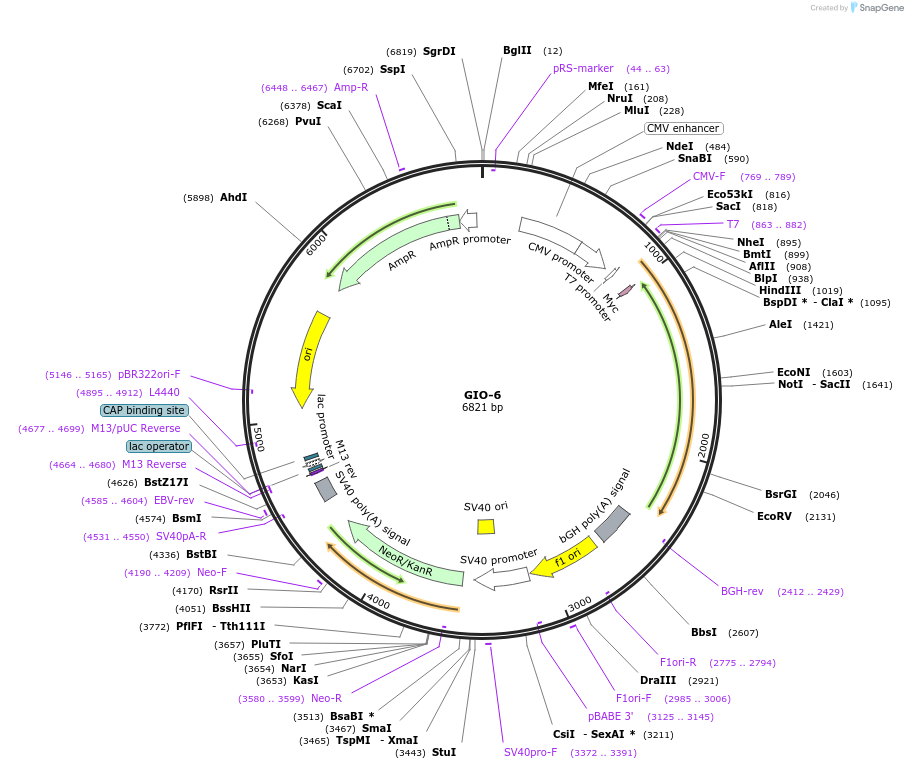GIO-6
(Plasmid
#213390)
-
PurposeExpresses a chimeric cytokine between IL-6 and OSM
-
Depositing Lab
-
Sequence Information
Ordering
| Item | Catalog # | Description | Quantity | Price (USD) | |
|---|---|---|---|---|---|
| Plasmid | 213390 | Standard format: Plasmid sent in bacteria as agar stab | 1 | $89 | |
Backbone
-
Vector backbonepcDNA3.1
-
Backbone manufacturerBioCat GmbH
- Backbone size w/o insert (bp) 6196
- Total vector size (bp) 6818
-
Vector typeMammalian Expression
-
Selectable markersNeomycin (select with G418) ; Kanamycin
Growth in Bacteria
-
Bacterial Resistance(s)Ampicillin, 100 μg/mL
-
Growth Temperature37°C
-
Growth Strain(s)DH5alpha
-
Copy numberHigh Copy
Gene/Insert
-
Gene/Insert nameGIO-6
-
Alt nameChimeric synthetic cytokine between IL-6 and OSM
-
SpeciesH. sapiens (human)
-
Insert Size (bp)605
-
GenBank IDNC_000007.14 NC_000022.11
- Promoter T7
-
Tags
/ Fusion Proteins
- IgG1-Fc-tag (C terminal on backbone)
- Myc-tg (N terminal on backbone)
Cloning Information
- Cloning method Restriction Enzyme
- 5′ cloning site HindIII (not destroyed)
- 3′ cloning site NotI (not destroyed)
- 5′ sequencing primer TAATACGACTCACTATAGGG
- 3′ sequencing primer AGGCACAGTCGAGGCTG
- (Common Sequencing Primers)
Resource Information
-
A portion of this plasmid was derived from a plasmid made byThe molecule was structure-based in-silico designed. The DNA was then synthesized and ordered from BioCat GmbH
Terms and Licenses
-
Academic/Nonprofit Terms
-
Industry Terms
- Not Available to Industry
Trademarks:
- Zeocin® is an InvivoGen trademark.
These plasmids were created by your colleagues. Please acknowledge the Principal Investigator, cite the article in which the plasmids were described, and include Addgene in the Materials and Methods of your future publications.
-
For your Materials & Methods section:
GIO-6 was a gift from Jurgen Scheller (Addgene plasmid # 213390 ; http://n2t.net/addgene:213390 ; RRID:Addgene_213390) -
For your References section:
Engineered interleukin-6-derived cytokines recruit artificial receptor complexes and disclose CNTF signaling via the OSMR. Rafii P, Cruz PR, Ettich J, Seibel C, Padrini G, Wittich C, Lang A, Petzsch P, Kohrer K, Moll JM, Floss DM, Scheller J. J Biol Chem. 2024 May;300(5):107251. doi: 10.1016/j.jbc.2024.107251. Epub 2024 Apr 1. 10.1016/j.jbc.2024.107251 PubMed 38569939



